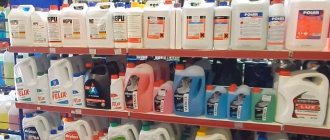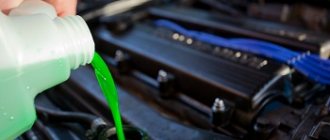Among motorists around the world, there have been ongoing debates for many years about whether motor oil from different manufacturers is compatible. There is also debate about whether it is possible to mix lubricants made from different base fluids. These are really difficult questions. A lot depends on the specific composition of each of the motor oils being mixed. Let's try to figure out what actions can be taken and what actions are extremely undesirable to do.
Why do motorists mix oil compounds?
If the car has just been purchased, its owner, as a rule, does not have any problems. Oil changes are carried out according to a planned schedule; The official dealer has in stock the oil composition that the engine needs. Therefore, happy owners of new cars don’t have to worry. This continues until the end of the warranty period or mileage.
Difficulties and difficulties arise if the warranty has expired. You can continue to fill with the same oil that was used during the warranty period. But the variety of motor oils is so great, and their advertising is so powerful, that there is a temptation to use a “cooler” lubricant.
By the end of the warranty period (from 2 to 4 years without mileage limitation), the car in many cases has already covered up to 100 thousand kilometers. If this happens, the question arises of switching to a different high-temperature oil viscosity. For example, before this, an oil composition with a viscosity of 5W-30 was poured. Now it is advisable to switch to another indicator - for example, 5W-40 or 10W-40 (if such a viscosity is provided by the car manufacturer in the technical documentation).
No matter how you wash the engine and drain the used lubricant, up to 0.5 liters of the old oil composition will still remain in it. Flushing fluid will also be added here, which has a negative effect on engine parts if left in the engine for a long time. So, whether you want it or not, the old used composition will be mixed with new oil.
Another situation is when the oil level drops to critical. The reasons may be different - a large waste, if the oil composition is of poor quality, or a leak in the lubrication system. Be that as it may, you will need to add oil fluid, but there is nothing at hand except lubricant of a different viscosity and from a different manufacturer.
This is another reason why drivers sometimes resort to forced mixing of motor oils.
Flushing
Flushing the engine is quite simple. If you start pouring synthetics of a proven brand into the engine, you don’t have to rinse it. In general, flushing is performed when replacing a spent petroleum product with another. The algorithm is as follows:
- Warm up the power unit, turn it off, and drain the used oil product. Be careful - the grease is very hot and you can get seriously burned. Use special gloves that protect the skin of your hands.
- Remove the old oil filter and fill in the flushing fluid.
- Start the power unit, let it warm up and idle for fifteen to twenty minutes. During this time, flushing should completely clean the engine, if, of course, it is of sufficient quality and purchased in a good store.
- Drain the flushing fluid. Drain the grease until all of it flows out and stops dripping.
- Install a new oil filter and fill with fresh motor oil. The consumable must be suitable for your power unit.
Any motorist can carry out the procedure. Anything can happen in life, sometimes there is no other choice but to fill in the wrong petroleum product. This is better than driving without any lubricant at all.
However, the easiest way to prevent such situations is to always carry a spare canister of motor oil with you.
To select the correct lubricant, it is recommended to contact an experienced motorist or car service employee. One of the reasons why problems occur in the engine is the filling of the wrong petroleum product.
Therefore, the choice of motor oil must be taken with full responsibility. This way you will avoid the occurrence of various malfunctions in the motor and significantly increase its service life.
What lubricants are used today?
Any of the motor oils used today consists of two components: a base composition and an additive package. They are designed to provide anti-friction, detergent, anti-oxidation, anti-corrosion, dispersive, viscous, and other properties of lubricant compositions over a wide temperature range. From negative in a cold engine to high in the cylinder-piston group of a running engine.
If a cold engine is started in frosty weather, the oil must have sufficient fluidity to quickly get through the channels to the vital components and parts of the engine. Otherwise, it will start to run dry, which can lead to severe wear. Thickening of a low-quality lubricant, even in slight frost, can kill an engine in one winter.
At operating engine temperatures from (150 to 200°C), it should not become too liquid, as it must form a fairly stable oil film between the rubbing surfaces. Otherwise, it will tear and the parts will again run dry. Based on their basic composition, oil liquids are divided into four types:
- mineral;
- semi-synthetic;
- hydrocracking;
- synthetics.
According to the American Petroleum Institute classification, all base compounds are divided into 5 groups.
- Group 1 – compositions obtained from crude oil using selective purification and dewaxing technologies.
- 2nd - liquids obtained by modifying the compositions of the 1st group by hydroprocessing. With this technology it will be possible to further reduce the content of paraffins and aromatic compounds.
- 3rd – bases of the second group, processed by catalytic hydrocracking. Maximum purification of oils from nitrogen and sulfur impurities, aromatic polycyclic compounds. As a result, the viscosity index is almost the same as that of synthetics.
- 4th – true synthetics, created by chemical synthesis from light hydrocarbons. It is based on polyalphaolefins (PAO).
- The 5th group consists of oils based on substances of organic and inorganic origin that are different from the first 4 groups. A good example is esters, on the basis of which synthetics with the best characteristics are created.
Semi-synthetics are obtained by adding synthetics to the mineral base after hydroprocessing. In most cases the ratio is 70% to 30%.
Synthetics
Synthetics are the best oil fluid according to auto manufacturers and motorists. It is produced in a laboratory, from a processed petroleum base or through molecular synthesis.
During the manufacturing process, many chemical tests are carried out, and the most complex components of organic synthesis are used.
The produced motor oil is resistant to oxidative processes, which cause deterioration in the performance of other types of motor oils, leading to various engine problems.
Synthetics do not interact directly with engine parts. It increases the compression volume in the internal combustion engine. This ensures a reduction in fuel consumption and simplifies engine starting in low-temperature conditions.
However, synthetic petroleum products have certain disadvantages. First of all, they are expensive. Not every driver can afford to buy synthetics. This is due to the high cost of producing synthetics.
In addition, the operating loss of synthetic motor oil is higher than that of other lubricating fluids. Because of this, synthetics cannot be poured into old, worn-out engines. Of course, it will not harm the functioning of the motor, but it will not bring any benefit either.
Using the machine will cost too much. It is better to immediately use mineral/semi-synthetic oil.
Lubricants from different manufacturers
If you mix semi-synthetics or synthetics from different manufacturers, then they will probably differ in additive packages, even if the synthetic component is the same - based on PAO.
Judging by the above, these packages are quite complex in their composition. For each manufacturer, additives are the know-how that distinguishes its products from competitors. If you mix formulations from different manufacturing companies on the same base, there is no guarantee that their additives will not conflict. At the very least, you can get a general deterioration in the quality indicators of such a “cocktail”.
Synthetic compounds from different brands can only be mixed if they have the same tolerances according to the American API standard or the European ACEA standard. Such lubricant compositions, having different characteristics, may be intended for different types of engines; in this case, their mixture is undesirable.
For example, the API SL class is intended for engines manufactured from 2000 to 2004. API SM applies to engines manufactured since 2004, and the SN class is designed for modern engines. These are Low SAPS oil formulations with a minimum content of sulfated ash, phosphorus and sulfur for compatibility with modern exhaust gas aftertreatment systems and better energy saving.
Mineral oils and the possibility of combining them with other types of oils
Is it possible to mix synthetics and mineral water? This question worries many car enthusiasts who use natural lubricants.
It is allowed to combine synthetic products based on polyalphaelins (PAO) with mineral oil.
Other types of synthetic materials combine worse with mineral ones. Therefore, it would be relevant to check with official representatives of the manufacturer or at least with service center specialists about the possibility of such a mixture.
With less risk, mineral oil can be mixed with semi-synthetics.
Lubricants from one manufacturer
If you mix oils from the same brand - for example, synthetics with synthetics of different viscosities - the picture is completely different. As a rule, this can be done because in this case the manufacturer mixes the base composition with the same additive packages. Only the viscosity differs. This may mean that the viscosity modifiers are added in a slightly different proportion.
You can safely drive with such a mixture until the next oil composition change, without fear of any additive package conflicts. The overall viscosity will simply shift. For example, if you mix 5W-30 with 10W-40, you get a non-standard value of 8W-35. This will not affect fluidity much; the oil will be a little thinner in a running engine. The low-temperature viscosity threshold will also become slightly higher.
Problem with additives
The problem of mixing two bases (synthetics and semi-synthetics) is not the only one. When you add one oil to another, you are also mixing additives. Additives are chemical compounds that are derived using special formulas. Their composition is unclear, since the formulas are kept in the strictest confidence. Each manufacturer adds its own additive package to a certain product, so there are no two different lubricants with the same base and the same additive package.
Is it possible to mix semi-synthetics and synthetics with different additives? It is impossible, because when different chemical compounds (unknowns) are mixed, some of them precipitate. As a result, the oils lose their lubricating properties. If the additives responsible for cleaning the engine precipitate, the cleaning effect is lost. The same can be said about other additives.
Note that this is a rather controversial issue, and not all motorists agree with the statement that additives precipitate when mixing lubricants. It is possible that this is not true in all cases. Sometimes such reactions may not occur. In any case, it’s best not to take any risks without extreme measures, because even oils from the same manufacturer, but on a different base, may contain different “conflicting” additive packages that precipitate when mixed.
A mixture of semi-synthetic and synthetic lubricant
If a fully synthetic lubricant contains additives compatible with its base, then a semi-synthetic product contains about 70% of the mineral component. This suggests that their additive packages may be different, even if the oil fluids are of the same brand. On this basis, it can be argued that mixing such oils is a risky procedure. You should not drive with such a mixture for a long time, especially if the motor fluids are of different brands.
Additives may conflict with each other. For example, a mineral base requires a relatively large amount of stabilizing viscosity modifiers, since its base composition has a low viscosity index. And in synthetics, this indicator is provided by the base itself; it does not need viscosity modifiers in such quantities.
Depressant additives that reduce the pour point are also not needed in large quantities by the synthetic composition, unlike the mineral one. So what will happen? The mixture of these oils will receive increased high-temperature viscosity due to additives to the mineral component. This will not lead to anything good, because the fluidity of the mixture will decrease, and its access to engine parts may be difficult.
The best option is if synthetic oil is added to semi-synthetic oil. Such a mixture can be made, especially if the oil liquids are of the same brand. Synthetics, being of higher quality, will not significantly change the viscosity parameters, especially since they are usually more fluid.
Mixing Guidelines
If the situation is critical, try mixing synthetics with semi-synthetics. But be prepared for possible risks. The procedure is carried out according to certain rules. Secrets and recommendations will help you avoid negative consequences.
Mixing Instructions:
- For the procedure, oils are selected on the same basis. Then it is possible to avoid additive conflicts.
- Pay attention to viscosity. It's best when this indicator is the same. High-quality synthetics can regulate viscosity, but it is better not to abuse this.
- It is better to choose lubricant from one manufacturer.
If all three recommendations are followed, then no problems will arise. Then the additives will interact perfectly, and the base will not precipitate. But in reality this happens extremely rarely. The main thing is to choose the most similar compositions. You cannot mix winter and summer oil, as the viscosity there is very different. This is acceptable with universal petroleum products, but the quality of the lubricant will deteriorate in any case. Such oil will not perform its functions well. You won't be able to ride it for a long time. It is better to contact the service and perform a flush and a complete replacement of the lubricant.
Similar compositions are allowed to be combined, but is it possible to mix synthetics with semi-synthetics? It is not advisable to do this. Additives may begin to conflict and the viscosity index will deteriorate. The engine may seize. Therefore, the procedure is allowed to be performed only if the compositions are the same. But it is best to flush it before adding new oil.
conclusions
Mixing oils from different manufacturers, even if they have similar basic compositions, should be done very carefully and only in the most extreme cases, when there is no other choice, for example, you need to drive home or to the nearest service station. If such a situation arises and you have to add oil from another manufacturer to the main composition, you should get rid of such a mixture as quickly as possible, since it is quite possible for the engine to coke due to a conflict in additives. After this, you can flush the engine and fill it with suitable lubricant. After this, after driving about 5 thousand kilometers, make another replacement so that you can finally get rid of the remnants of the mixture that was in the engine.
Characteristics of oils
The oil composition includes a base and a complex of additives. They determine the characteristics of the petroleum product. Additives perform antioxidant, anti-corrosion and cleaning functions. They also determine viscosity, temperature parameters of oil use and dispersion properties.
For frosty weather, the viscosity of the oil allows the liquid to quickly penetrate all engine elements. If the motor runs dry, serious damage occurs. When low-quality lubricant thickens, the engine can be irrevocably damaged in one season. The channels become clogged, which leads to jamming.
In hot weather, you will need to monitor the viscosity of the oil product. Lubricants coat parts, reducing friction. A low viscosity index will again lead to the engine running dry.
Classification of lubricants depending on composition:
- Mineral based;
- Synthetic products;
- Semi-synthetic oil;
- Hydrocracking.
The characteristics of synthetic and semi-synthetic oils have certain differences. So synthetics are made artificially using synthesis. This lubricant is now the most popular. Its properties eliminate leaks and other breakdowns in the fuel processing mechanism. In addition, the product does not come into direct contact with the motor elements. Among the disadvantages is the high cost.
Semi-synthetic oils combine natural and synthetic bases. The percentage depends on the manufacturer. The quality of the product is average. It has low viscosity, but high oxidizing ability. You have to change the lubricant often, especially in frosty weather. But the cost of semi-synthetics is more affordable.
Adding oil on the way
Often it is on the road that the need to mix lubricant arises; what should you do if this need arises? Car owners often assume that if they mix lubricant from one company, it will not cause any harm to the engine - this is a misconception. Their compatibility is in question.
Even lubricants from the same brand but from different bottles can have different molecular structures. This may occur due to a change in equipment at the enterprise, the use of more or less chemical raw materials or other components. Different molecular compositions will cause resonance inside the engine and increased release of slag, and this will not end well.
In the event that you have to add lubricant during a long trip, then as a last resort, you can mix synthetics with semi-synthetics, but when approaching the nearest technical post, you need to get rid of the lubricant that forms inside the car. Moreover, you need to get rid of it by washing the engine as thoroughly as possible using special flushing oils.
Main advantages and differences of lubricants
It is simply impossible to say exactly which 10w40 motor oil is of better quality: synthetic or semi-synthetic, since each of them has its own pros and cons, distinctive characteristics and compatibility only with certain brands of cars.
Let's look at the main differences between these types of motor lubricants:
- Vehicle age. It is believed that 10w40 synthetics are more suitable for new cars, while semi-synthetic mixtures should be used for old and worn ones. They have a more restrained effect on engine parts and are much more effective in practice.
- Molecular composition of the chemical basis. Synthetic lubricant 10w40 is more saturated with elements that have increased thermal and chemical resistance. It functions perfectly in engines under any climatic conditions and is practically resistant to oxidation processes. If such motor oil is suitable specifically for your car, then its engine is guaranteed one hundred percent high level of wear protection! However, there is an important point - the synthetic mixture must be used from the very beginning of the vehicle’s operation.
- Fluidity. This is one of the main parameters that allows you to answer the question - which motor oil is more functional. In practice, 10w40 synthetics have higher fluidity. This means that such a liquid has a high penetrating ability and it can completely cover all parts of the car engine.
- Price. Semi-synthetic motor oil 10w40 or mixed, as it is most often called, also has its advantages and positive differences from synthetic. In particular, 10w40 blended motor oil is better than synthetics in terms of cost. It has a more affordable price, since this oil consists of only half of expensive synthetics, the rest is a mineral component.
- Effect on the car engine. As practice shows, a mixed type of lubricant can lead to the formation of microscopic cracks in the rubber parts of the engine over time. These cracks are usually filled with sediment, which oxidizes. This means that when using such motor oil, the overall life of the car engine is significantly reduced. In this case, the synthetic substance is more profitable! Although it is expensive, it does not have a detrimental effect on the car’s engine. It perfectly lubricates and extends the life of the entire unit.
Common features
When comparing synthetic oils and semi-synthetic lubricants, car enthusiasts are interested in knowing what they have in common.
In fact, there is not much in common between the oils. In fact, both lubricants are designed to perform the same tasks. That is, two compositions are aimed at providing engine lubrication.
If you do not take into account the chemical composition, since semi-synthetics also contain some pure synthetics, there is nothing else in common between them.
How to combine liquids correctly
Not all oils can be combined with each other. It is likely that there will be no serious negative consequences, but this is not a desirable action at all. It would not be superfluous to adhere to certain principles when combining these means.
Is it possible to mix synthetic oil with semi-synthetic oil from different brands? It is best to combine products from one manufacturer. This is due to the same formula. Such oils will not compete with each other and will last well until further replacement.
Therefore, it is better to use materials from one company. But due to the fact that due to a shortage of products, this issue becomes relevant quite often, modern brands have found a way out of this situation.
Many brands today allow the option of combining different oils and sell their products with certain standards that allow the combination of liquids.
This is how you can eliminate the occurrence of negative consequences when using your motor, but you can resort to this method only in rare cases.
What happens if you mix synthetics and semi-synthetic viscosity? Trademarks do not advise performing such an action, but if there is no way around it, then you need to give preference to the same manufacturer as in the past.











